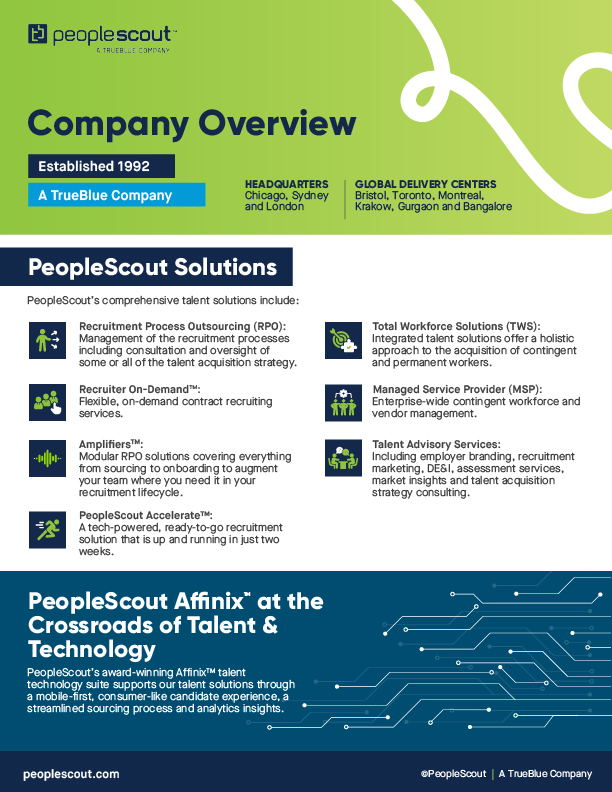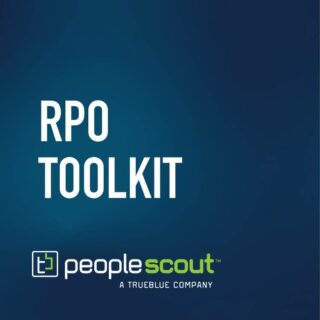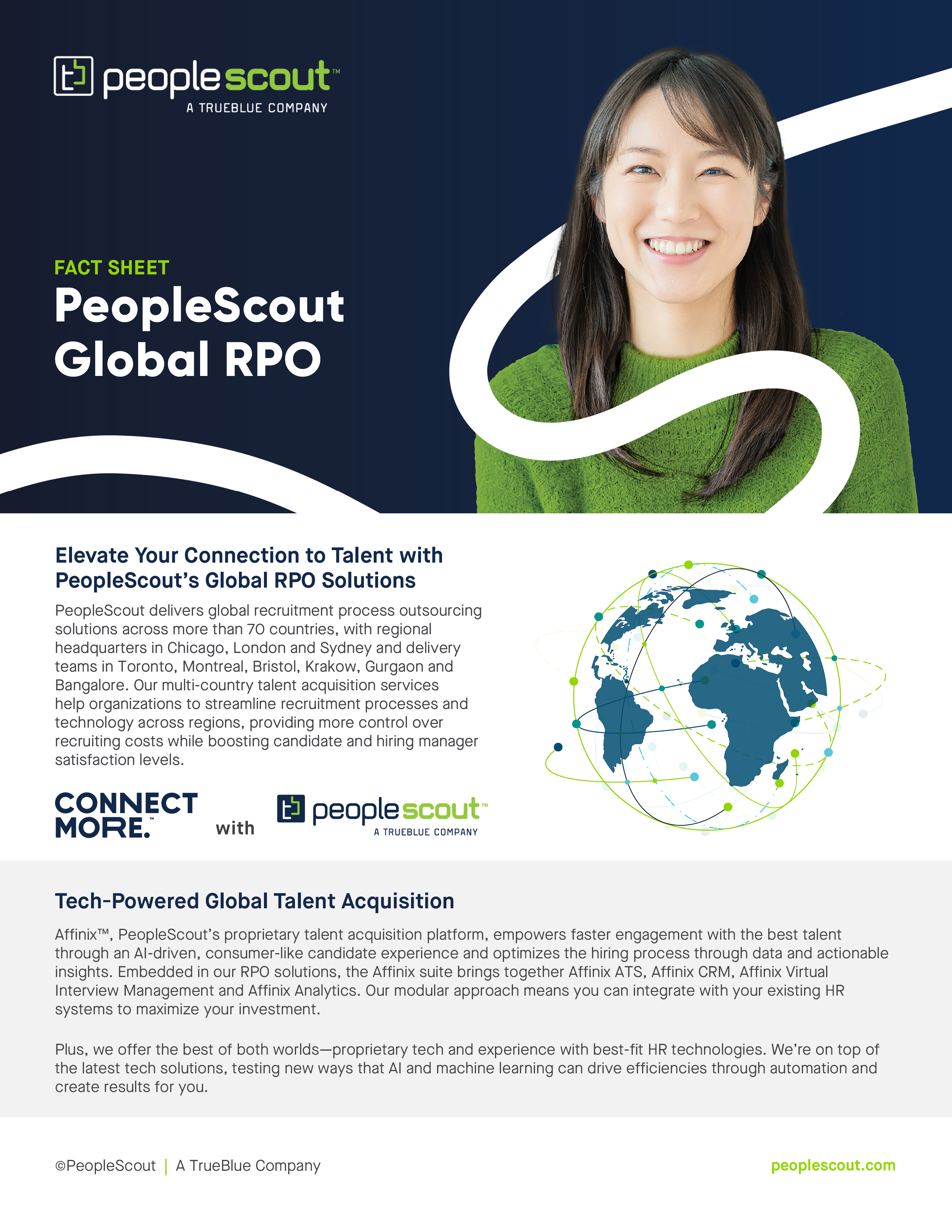In a world where the talent market is constantly evolving, PeopleScout knows that cultivating deeper, more meaningful connections is imperative. Now, as we unveil a refreshed identity, we build on the service we’ve delivered for over 30 years, delivering more insights, more imagination and more integrity.
Connect More™ is our guiding principle. It reflects our unique approach that blends experience, insight and action to help employers build powerful connections with talent.
We’re redefining what it means to a be talent acquisition partner.
Too often we hear from clients about experiences they’ve had with other talent solutions providers in which one thing was said during the sales pitch only to have the stakes change once the ink was dry. Or times they’ve been forced into cookie-cutter processes that don’t support their unique needs.
That’s why at PeopleScout we strive to do the opposite. We believe in keeping promises. We believe that listening creates a better experience and leads to better outcomes. We’re not perfect, but if we mess up, we make it right.
We’re proud and humbled to say that this philosophy has led to some of the most enduring client relationships in the talent acquisition space—a testament to our commitment to creating connections that are truly meaningful.
PeopleScout’s refreshed brand is grounded in differentiators that drive tangible value for our clients:
Proven Delivery
For over 30 years, PeopleScout has built our services on integrity, building trust through transparent communication and a proven track record of success.
What That Means for You:
You get a talent partner like no other to help you tackle your workforce challenges—large and small. Plus, as part of the TrueBlue family of brands, we are uniquely positioned to handle complex talent programs like no other firm in the world.
Meaningful Connections
PeopleScout has the demonstrated ability to connect with the most sought-after talent. From software engineers to neonatal nurses. From Seattle to Singapore.
What That Means for You:
Our global delivery centers offer talent solutions across North America, EMEA and APAC, meaning we can grow with you as your needs change.
Talent Advisory
With one of the largest in-house talent advisory teams in the industry, we’ve got a wide range of experience with talent audiences across industries, skill sets, demographics and geographies. We are problem-solvers, creatives, organizational psychologists and operational experts.
What That Means for You:
Whether you need an award-winning candidate attraction campaign, a differentiated employer brand, market insights to fuel big decisions, a memorable candidate assessment experience or DE&I consulting—we have fresh ideas to help you stand out as an employer of choice.
Data & Insights
Sometimes you don’t know what you don’t know. We’re dedicated to arming you with the sharable, digestible insights you need to tell the right stories in your business so you can stand out and get ahead.
What That Means for You:
You can capitalize on the latest market analysis, AI tools, thought leadership and competitive intelligence to supercharge your people strategy.
Human Touch
We bring a personal touch to our engagement with passive candidates that ignites excitement about your opportunities. From the second we grab the candidate’s attention to the minute they walk through the door—we deliver a seamless candidate experience that turns applicants into advocates.
What That Means for You:
Whether you need to fill executive, leadership or niche roles our global search teams deliver top-notch, future-ready talent.
Digital Transformation
As digital transformation reaches talent acquisition, we’re helping our clients get ahead. Affinix®, PeopleScout’s proprietary total talent suite, provides candidates with a digital-first experience and leverages AI, automation and data analytics to remove friction and improve outcomes. Plus, we’re on top of the latest tech solutions, testing new ways that AI and machine learning can create results for our clients.
What That Means for You:
You get an upgraded tech-ecosystem that blends digital efficiency with human expertise to create personalized experiences for both candidates and hiring managers.
Ultimate Scalability
We’ve scaled up to handle the full-cycle, global recruitment of tens of thousands of annual hires for one of the world’s largest hotel brands. We’ve scaled down to hire a few dozen specialist engineers for an automotive start up. And we’ve handled everything in between.
What That Means for You:
Whether you need specialty, professional, volume or contingent hiring solutions—our unique blend of insight, creativity and technology creates an employer brand-steeped candidate experience talent will never forget.
Speed and Agility
In this tumultuous era, talent acquisition teams are struggling to respond quickly to sudden fluctuations and hiring peaks. That’s why we’ve created flexible solutions like Accelerate™ and Amplifiers™. Purpose-built for modern talent programs, our solutions provide employers with the agility required to compete in today’s talent market, address immediate hiring needs and deliver results faster.
What That Means for You:
You get focused support for peak hiring, hard-to-fill positions, compressed time frames and more—however it works best for you—without the lengthy implementation.
Value
Organizations of all sizes trust PeopleScout’s efficient recruiting processes and quick-deploy solutions that improve time-to-hire and retention rates, delivering the best talent matches and maximizing ROI.
What That Means for You:
We measure our every move, idea and recommendation—so you know you’re spending your budget where it matters most.
Diversity, Equity & Inclusion (DE&I)
DE&I is top of mind for talent leaders, including all of us at PeopleScout. While much progress has been made, there’s still work to be done. That’s why every PeopleScout solution has a DE&I component. PeopleScout integrates DE&I best practices into every solution, helping clients build a more diverse and inclusive workforce.
What That Means for You:
We’ll help you gain a better grasp of where you are, where you need improvement and how to find the right path forward.
Are You Ready to Elevate Your Connection with Talent?
PeopleScout’s deep expertise in recruitment, employer branding, talent attraction and recruitment technology makes us a recognized leader in talent acquisition. We connect clients around the world with the talent they need through Recruitment Process Outsourcing (RPO), Managed Service Provider (MSP), Total Workforce Solutions, and talent and technology advisory services.
If you’re ready to elevate your connection with talent, let’s connect!








